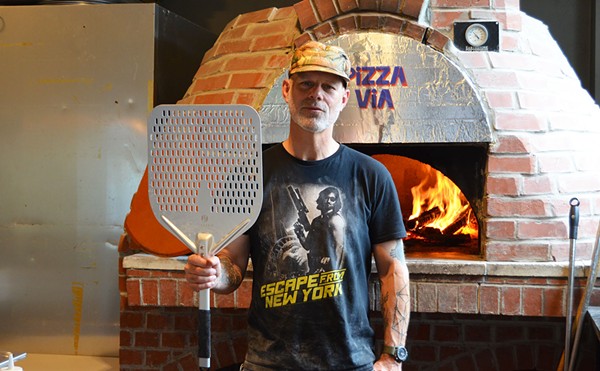Chef Alfred Portale, of New York City's Gotham Bar and Grill, launched the high-rise-food fad by erecting soaring structures intended to resemble Manhattan skyscrapers. Chefs who have followed suit are so amused by their own nifty constructions that they've taken to describing them on their menus in florid detail. The latest chic vertical shape is the cone. Chef Marcus Samuelsson, of Aquavit, a Scandinavian restaurant in New York and Minneapolis, packs wasabi sorbet into salmon-skin cones. The aerial trend has rebounded into an absurd antidote known as "deconstructed food," in which ingredients are presented in separate little mounds -- the mise en place for a single dish. The vegetable degustation menu at Charlie Trotter's, in Chicago, lists a deconstructed ragout of tiny carrots and beets with red-cabbage/red-wine sauce, white-bean emulsion and Perigord black truffles. But Dill wastes no time on such fribble. Her pretty plates, adorned merely with simple garnishes and ribbons of sauce, are a metaphor for her down-to-earth cooking style: Consistency, versatility and flavor are integral, but she refuses to chase after the trendiest or fanciest ingredients and avoids anything that smacks of gimmickry. That means no sow's ears or salmon bellies, no truffle custards or raisin emulsions, no calf's-brain foam or parsley water.
The servers at Sidney Street reel off each selection by memory, with only smudged blackboards for cheat sheets. But this crew is sharp, and their adroitness is evident throughout the meal. A takeout menu, available on request, labels the restaurant's cuisine "contemporary American and Continental." All of America and Europe is a sufficiently broad geographic sweep, granting Dill license to cook just about anything she wishes -- and she does, with an impressive 17 entrée selections on a typical night.
One of them, Asian-style barbecued salmon with shiitake-mushroom salsa, is perhaps the most appealing salmon dish in St. Louis, a city in which the popular fish appears on just about every restaurant menu. The buttery shiitakes pair well with the fatty Norwegian salmon and the sweet glaze, an intriguing amalgam of hoisin and oyster sauces, sherry, garlic and a Thai chile paste called sriracha. Another successful entrée, a nicely crosshatched piece of snapper lacquered with apricot marmalade, is similar in conception to the salmon. The dinner plates are rounded out with more flat food -- three baby carrots and a few snap peas. In fact, each plate is garnished with these same vegetables. Dill's imagination seems to have been depleted in conceiving the entrées, leaving her no zeal with which to create imaginative side dishes.
Dill has a knack for preparing seafood, so we also ordered sea scallops with polenta. These shellfish usually measure about the diameter of a silver dollar. Bay scallops, by way of contrast, are about the diameter of a nickel, whereas calico scallops have the silhouette of a pencil eraser and are sometimes passed off as the more desirable bays. Dill's scallops were handsomely seared but had a rubbery texture. Finally, we sampled filet béarnaise, a center-cut, short-loin steak grilled medium as ordered. The meat was supposed to have been stuffed with lobster and langostinos (an odd use of the Spanish word for prawns, rather than the French word langoustines), but no pocket had been carved into the steak. Instead, the meat had been haphazardly butterflied -- that is, lopped in half at the bone and unhinged like a waffle iron, with the seafood scampi heaped between the top and bottom flaps.
Sidney Street's appetizers, such as the lobster turnovers and the blue-cheese tartlets, are served in generous portions, so you might want to order a second starter as a main course. Doing so will shave a few dollars off your hefty tab: Every entrée except roast chicken runs $20 or more. The menu prices, of course, must cover expenses besides just the food (see sidebar), but it's difficult to find a similar St. Louis restaurant that doesn't offer several entrées under $20.
Nevertheless, Dill has clearly hit on a formula that works. In the forthcoming book Culinary Artistry, authors Andrew Dornenburg and Karen Page suggest that professional cooks fall into three categories. First there are the trade cooks, those who flip johnnycakes, replenish steam tables and plunge frozen Tater Tots into fry baskets. Their job is to turn tables quickly and fill their customers' stomachs to bursting. Next come the well-trained, accomplished chefs who view cooking as a craft. Their dishes appeal to all five senses, but taste is paramount. The last category is composed of chefs who consider themselves culinary artists, with food as their medium. These are the Thomas Kellers and Daniel Bouluds of the world, for whom every plate becomes a resplendent palette and every dish makes an esoteric cultural statement. Dill -- and most other St. Louis chefs, for that matter -- belongs to the second category, those who place diners' gratification before their own hunger for transcendent self-expression. But in the end, pleasing customers by masterfully plying the craft of cooking might be a more satisfying means of expression than arranging sublime ingredients in elaborate configurations. After all, with food as the raw material, even the cleverest creation will soon be toppled like a fragile house of cards.





